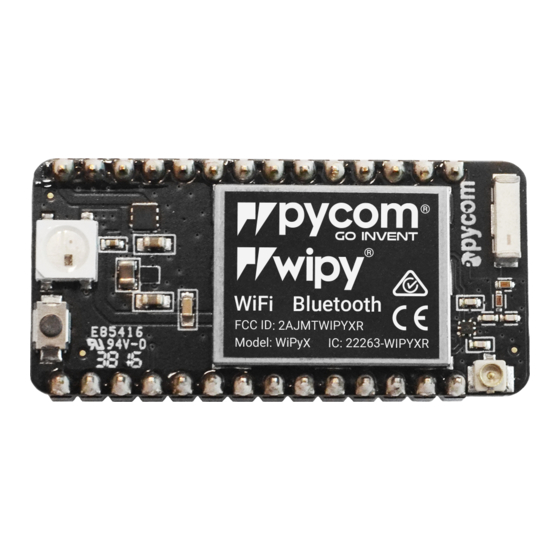
Summarization of Contents
About Pycom Modules
Preface
Introduction to the Pycom documentation site, outlining its structure and purpose.
Pycom Products Overview
Overview of Pycom's product range, including development modules and OEM options.
Getting Started with Pycom
1.1 Hardware Setup
Detailed instructions for setting up the hardware of Pycom modules.
1.2 Software Setup
Guide to installing necessary software for Pycom device development.
1.3 Programming Modules
Introduction to programming Pycom modules using MicroPython and Pymakr.
1.4 Device Registration
Instructions for registering Pycom devices for specific features like networking.
Pymakr IDE and Tools
2.1 Pymakr Installation
Steps to install the Pymakr plugin for Atom and Visual Studio Code.
2.2 Pymakr Tools and Features
Overview of Pymakr's console (REPL), run, and project management features.
2.3 Pymakr Settings
Description of various configuration settings available for the Pymakr plugin.
Pytrack and Pysense Modules
3.1 Introduction to Pytrack and Pysense
Overview of Pytrack and Pysense boards and their sensor capabilities.
3.2 Installing Software for Boards
Guidance on installing software and checking for updates for Pytrack/Pysense.
3.3 API Reference for Sensors
API details for accessing sensors on Pytrack and Pysense boards.
Tutorials and Examples
4.1 Introduction to Tutorials
Overview of the tutorials section, covering general and specific examples.
4.2 All Pycom Device Examples
Generic examples applicable to all Pycom devices and Expansion Boards.
4.3 LoRa Examples
Tutorials demonstrating LoRa functionality with LoPy modules.
4.5 LTE Examples
Tutorials for LTE CAT-M1 and NB-IoT functionality on cellular enabled modules.
Firmware and API Reference
5.1 Introduction to MicroPython Modules
Overview of MicroPython libraries and categories available for Pycom devices.
5.2 Pycom Modules Reference
Detailed reference for Pycom-specific modules like machine, network, and crypto.
5.3 MicroPython Libraries
List of standard Python libraries, MicroPython-specific libraries, and Pycom modules.
Product Information
6.1 Development Modules Datasheets
Datasheets for Pycom Development Devices including WiPy, LoPy, SiPy, GPy, and FiPy.
6.2 OEM Modules Datasheets
Datasheets for Pycom OEM Devices including W01, L01, L04, and G01.
6.3 Expansion Boards and Shields Datasheets
Datasheets for Pycom Expansion Boards and Shields like Expansion Board 3.0.
Pybytes IoT Ecosystem
8.1 Pybytes Introduction
Explanation of Pybytes as an IoT Ecosystem for controlling Pycom devices.
8.2 Getting Started with Pybytes
Step-by-step guide to creating a Pybytes account and connecting devices.
8.3 Adding Devices to Pybytes
Instructions on how to add devices to Pybytes via Firmware Updater or manual flashing.
Documentation Notes and Syntax
9.1 Documentation Notes Introduction
Guidance on the Pycom documentation's structure, syntax, and conventions.
9.2 Documentation Syntax Details
Explanation of syntax rules for classes, methods, and keyword arguments.
9.3 REPL vs Scripts
Comparison between executing code in the REPL and running it from a script.
Advanced Topics and License
10.1 Firmware Downgrade
Methods for downgrading device firmware using GUI or command line tools.
10.2 CLI Updater Usage
Guide to using the Command Line Update Utility for firmware management.
10.3 Secure Boot and Flash Encryption
Steps for using secure boot and flash encryption for firmware security.
11.1 License Information
Details on the MicroPython and Pycom software licenses.






Need help?
Do you have a question about the LoPy4 and is the answer not in the manual?
Questions and answers